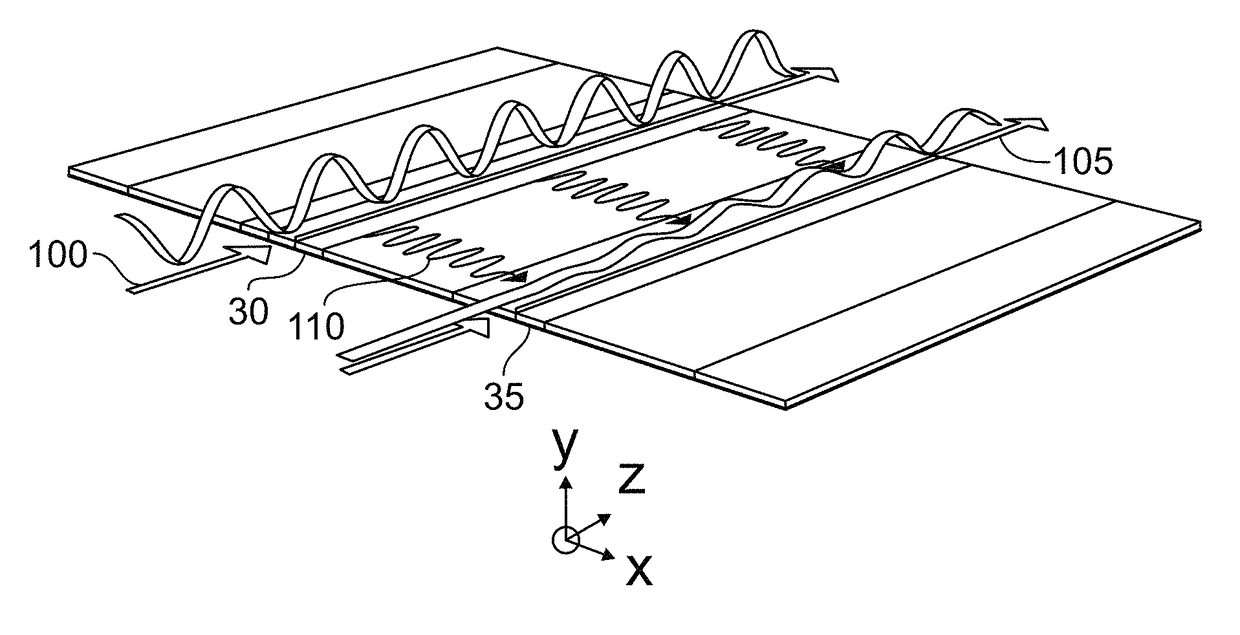On-chip photonic-phononic emitter-receiver apparatus
a phononic emitter and receiver technology, applied in the field of radiofrequency photonic devices, can solve the problems of low signal distortion, elusive optical wavelength insensitivity, and narrow-band rf filter that simultaneously achieves high optical power handling, and achieves strong photon-phonon coupling
- Summary
- Abstract
- Description
- Claims
- Application Information
AI Technical Summary
Benefits of technology
Problems solved by technology
Method used
Image
Examples
example 1
[0098]PPER platforms were fabricated as described above. In an example, the dimensions were:
a0=1 μm
b0=950 nm
c0=220 nm
r0=0.385 μm
t0=130 nm
W0=5.7 μm
N=6
Nc=6
Interaction length=7 mm.
[0099]A single-wavelength laser line at 1547 nm was intensity-modulated, using a Mach-Zehnder modulator, to synthesize pump waves E1a(ω1) and E2a(ω2) (equivalently, a pump wave and a local oscillator wave, as described above) for injection into Wg-A. The carrier-frequency component was suppressed by optimizing the bias voltage, so that only the two sidebands were injected into the waveguide.
[0100]Optical forces, generated through wave interference in Wg-A, drove phonon-mediated coherent information transduction in Wg-B through excitation of hybridized phonon supermodes. The phonon supermodes generated the new signal field Esb(ωs) through travelling-wave phase modulation of the probe wave E3b(ω3), which was injected into Wg-B at a wavelength of 1536 nm. The beat signal between the interf...
example 2
Superdome Engineering
[0109]As explained above, the PPER response is determined solely by phonon supermodes straddling both waveguides. These supermodes are controllable by engineering the PnC structure. For example, the center frequencies of PPER supermodes can be tailored by engineering the defect size Wo.
[0110]FIG. 19 provides two plots of the measured and normalized RF response, i.e. the emit-receive response, of a PPER system as a function of frequency. The two plots compare the effect of changing the defect size Wo. In both plots, the PnC design had N=Nc=6. The left-hand plot had Wo=5.7 μm, and the right-hand plot had Wo=5.2 μm.
[0111]It will be seen that although the lineshape did not change significantly, the center frequency shifted by 250 MHz as the defect size was lithographically varied from 5.7 μm to 5.2 μm.
[0112]The PPER transfer function can also be shaped by lithographically controlling N, Nc and Wo to control the frequency splitting and decay rate of the PnC supermode...
PUM
 Login to View More
Login to View More Abstract
Description
Claims
Application Information
 Login to View More
Login to View More - R&D
- Intellectual Property
- Life Sciences
- Materials
- Tech Scout
- Unparalleled Data Quality
- Higher Quality Content
- 60% Fewer Hallucinations
Browse by: Latest US Patents, China's latest patents, Technical Efficacy Thesaurus, Application Domain, Technology Topic, Popular Technical Reports.
© 2025 PatSnap. All rights reserved.Legal|Privacy policy|Modern Slavery Act Transparency Statement|Sitemap|About US| Contact US: help@patsnap.com



